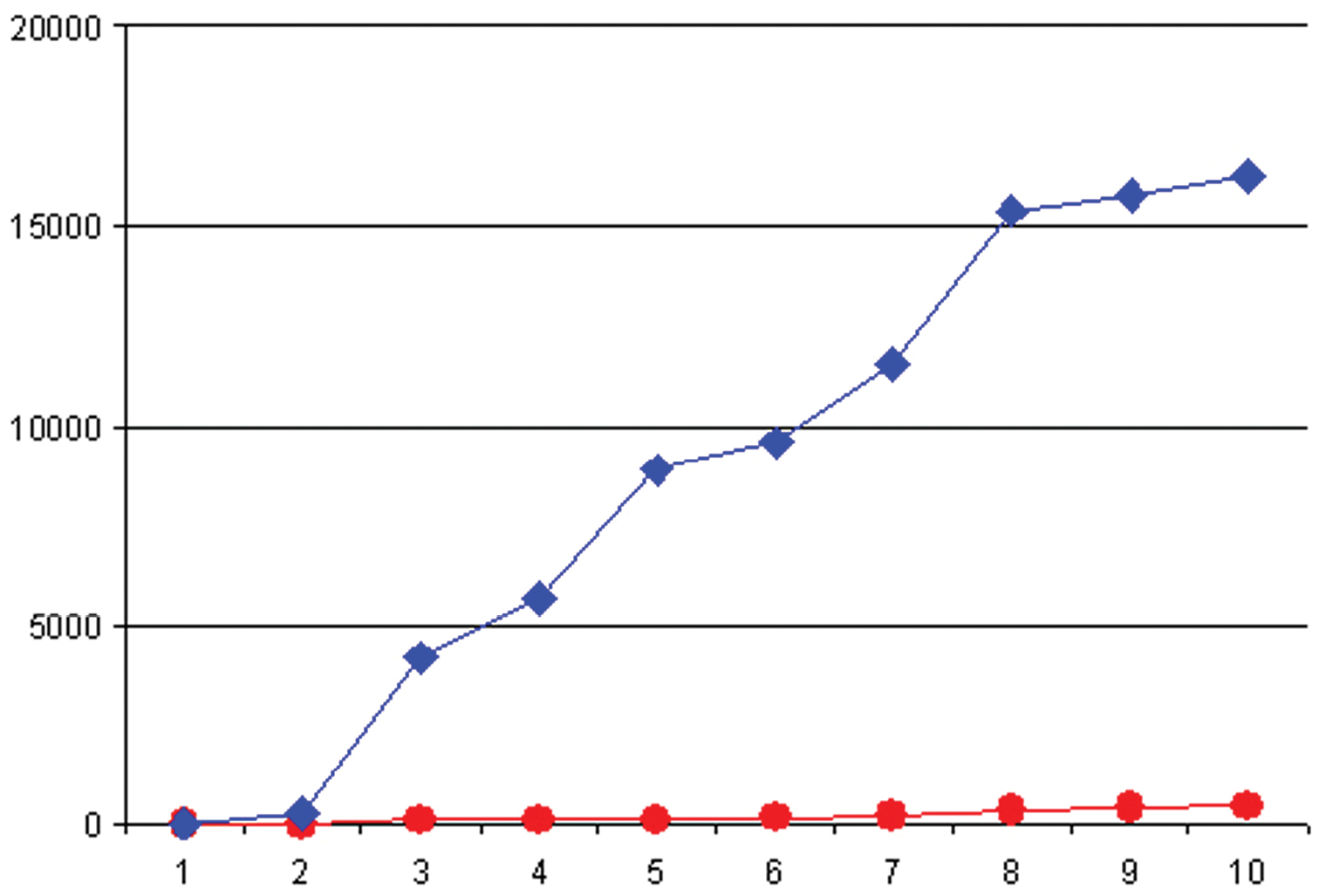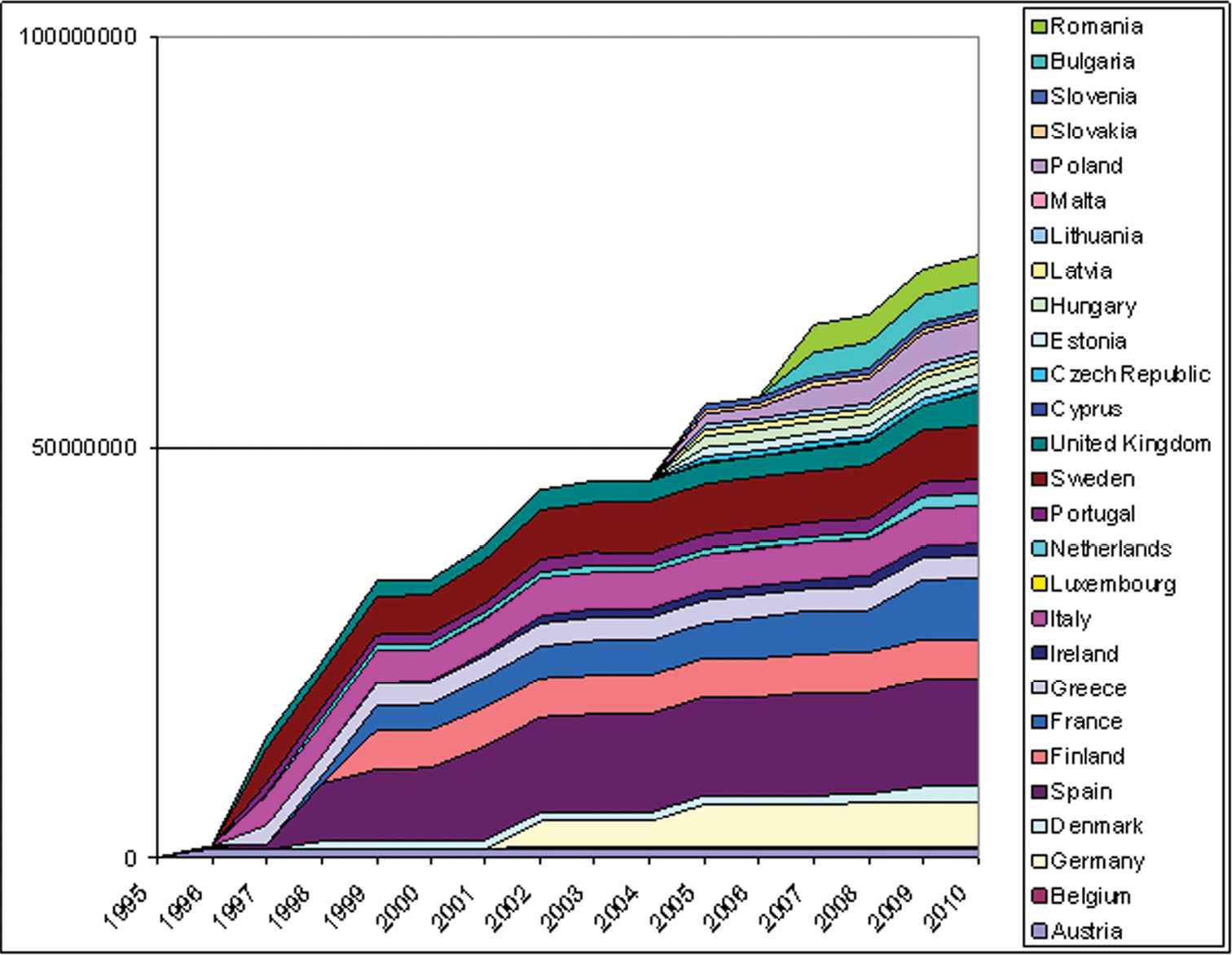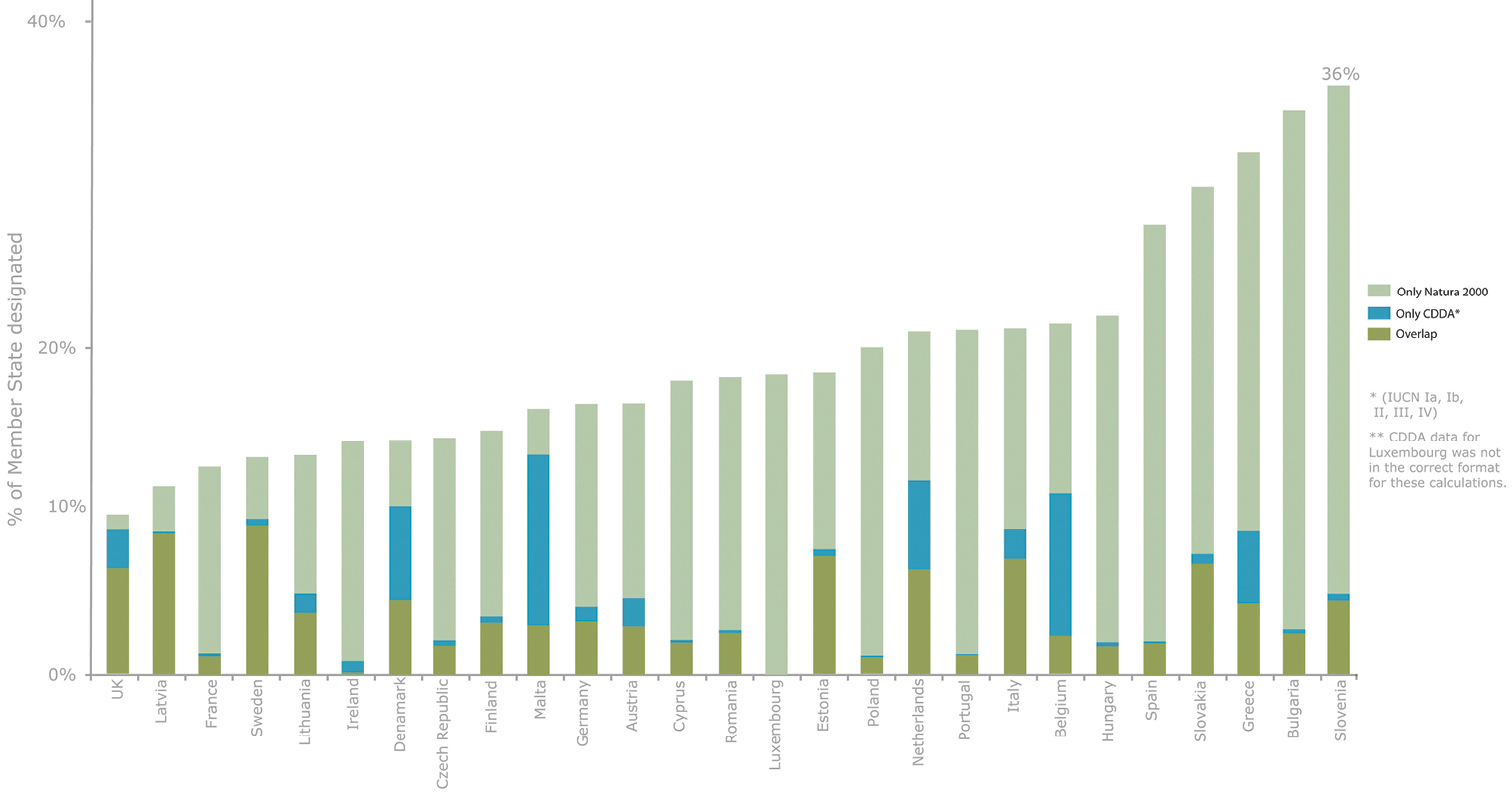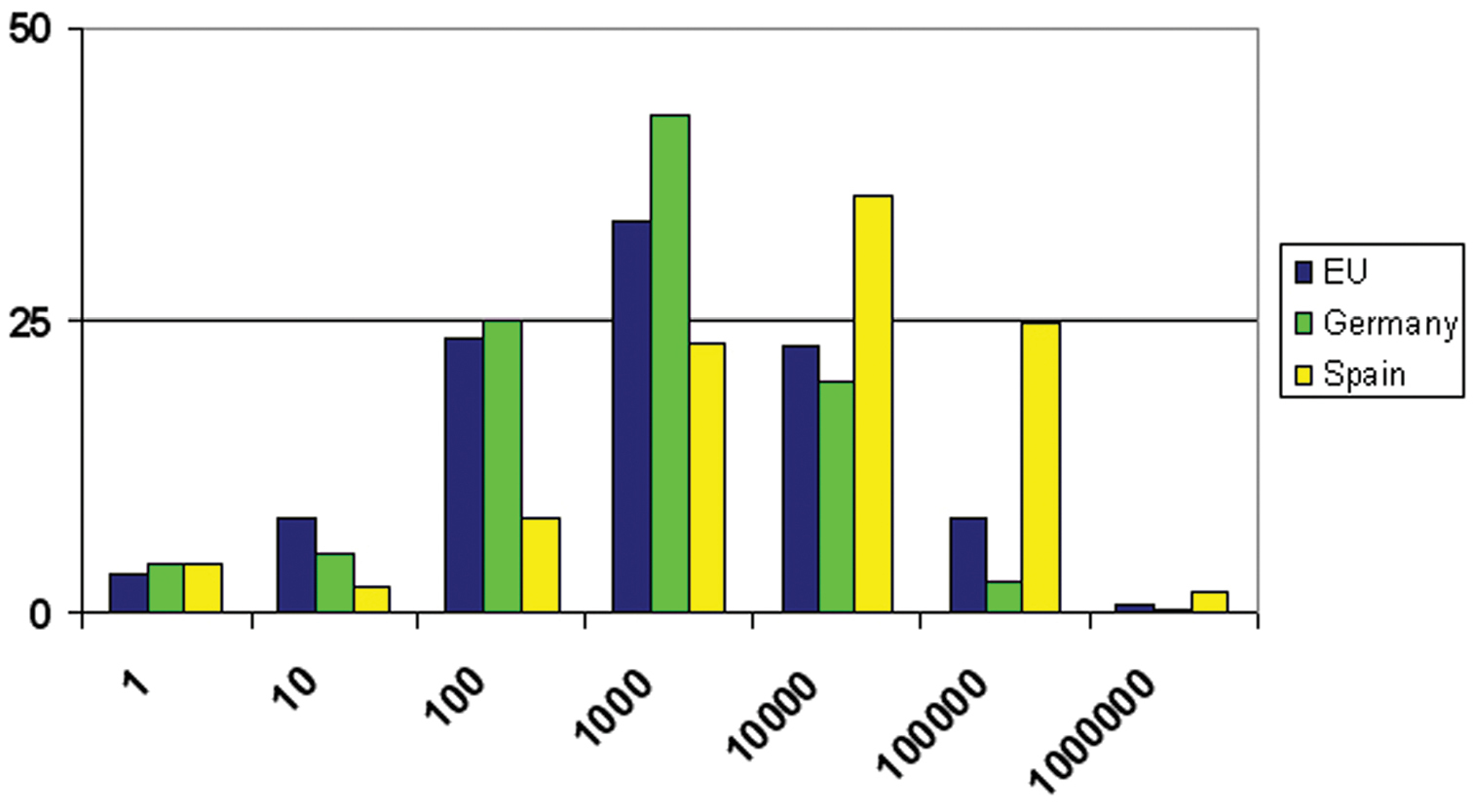






(C) 2012 Douglas Evans. This is an open access article distributed under the terms of the Creative Commons Attribution License 3.0 (CC-BY), which permits unrestricted use, distribution, and reproduction in any medium, provided the original author and source are credited.
For reference, use of the paginated PDF or printed version of this article is recommended.
In the second half of the 20th Century there was a growing awareness of environmental problems, including the loss of species and habitats, resulting in many national and international initiatives, including the creation of organisations, such as the IUCN, treaties and conventions, such as Ramsar and the Berne Convention, and the establishment of networks of protected areas. Natura 2000 is a network of sites in the European Union for selected species and habitats listed in the 1979 Birds Directive and the 1992 Habitats Directive. Under the Habitats Directive a series of seminars and other meetings have been held with agreed criteria to ensure a coherent network. Despite both scientific and political difficulties the network is now nearing completion.
Natura 2000, Birds Directive, Habitats Directive, Biogeographical seminars
During the second half of the 20th century there was an increasing awareness of environmental problems with publications such as Silent Spring by Rachel Carson (
Following the 2nd European Ministerial Conference on the Environment in 1976 Switzerland published a study recommending a European convention on nature conservation which led to the Berne convention on the Conservation of European Wildlife and Natural Habitats which was opened for signatures in September 1979 (
Within the European Union (in this paper EU refers both to the European Union and its predecessors) environmental issues were initially focused on the control of pollution although the 1973 first action plan on the environment identified migratory birds as a possible focus for EU action (
The EU ratified the Berne Convention in 1982 and, following pressure from NGOs and some Member States (MS), the European Commission published a proposed directive to implement the convention in 1988 (
Although there now exists a substantial literature on the two directives and the Natura 2000 network, little has been published on the development of the network and in particular the series of biogeographical seminars held to examine the Member State proposals for SCIs.
Establishing the network – a brief historySpecial Protection Areas are selected and designated by the Member States with no agreed EU criteria for site selection although many countries use criteria based on the Ramsar 1% of flyway population. Once sites have been designated, site details are forwarded to the European Commission using an agreed format, which since the mid 1990s has been in the form of a database. This ‘Standard Data Form’ (SDF) includes general information on the site (name, latitude & longitude, date designated, etc) together with information on the species present (
Progress in designating sites was slow at first (Fig. 1) and although there was no agreed process to evaluate site proposals, most Member States have been subject to legal proceedings for non implementation of the directive due to the slow rate of site designation (
Growth in the number of sites designated in the first ten years of the Birds Directive (1982-1992, red circles) and the Habitats Directive (1994-2004) blue squares). Note that some 10% of SPA and 5% of SCIs have no designation date in the database and that the EU grew from 12 MS in 1992 to 15 MS in 1995 and 25 MS in 2004 (Source ETC/BD).
The Habitats Directive has criteria for site selection given in Annex III and a system whereby Member States propose potential sites to the European Commission for approval and with a timetable for site proposal and subsequent designation. Although the timetable has not been respected, and many of the EU15 were subject to legal proceedings for failure to propose sites in time (
In response to Article 4 of the directive, the Commission, together with the Member States, and supported by the
At a meeting held in Funchal, Portugal, in November 1994 to discuss the Macaronesian region the concept of a ‘Reference List’ was developed and it was agreed that seminars should be held even though the proposals were clearly incomplete using the Macaronesian region as a pilot. The Reference List notes, which Annex I habitat types and Annex II species require sites in a given biogeographical region per country. This is not the same as a classic checklist as a species may be present but only as an occasional visitor such that site designation is not possible.
The 1997 criteria also introduced the so called “20-60% guidelines” but this was clearly to help focus discussion where most useful and was never meant to mean that a given percentage of a population of a species or area of a habitat type must be proposed. However, this has often been misunderstood to mean that at least 60% coverage of the population of a species or area of a habitat was required, especially by NGOs (e.g.
Further biogeographical seminars were held for Macaronesia in 1996 and 1997 where the methods used later elsewhere (see below) were developed. Meetings held for other regions before 1999 concentrated on agreeing the Reference Lists as very few sites had been proposed by the Member States and, with a few exceptions of mostly endemic species with one or very few known sites, most species and habitat types were not sufficiently represented in the embryo network.
By 1999 most countries had proposed enough sites to allow an analysis of the network species by species and habitat by habitat following the criteria agreed earlier and a series of seminars for the other biogeographical regions started in April 1999 in Vargön, Sweden, for the Boreal region and the Fennoscandian section of the Alpine region. For the EU15 it was necessary to have two or more seminars per region as it was clear at the first meeting that the proposals were not sufficient for all countries (e.g. for the first Atlantic meeting there were no German sites). However, the first seminars identified the habitats and species that clearly required additional sites and allowed a discussion on the interpretation of some of the Annex I habitats (see
The meetings were attended by representatives of the Member States, usually from the Ministries of Environment and/or agencies responsible for nature conservation, the European Commission, the ETC/BD and NGOs. A small number of experts identified by the ETC/BD were also invited, ideally these are independent of both the national authorities and the NGOs. This is not always possible in small countries and some invited experts had given advice to national authorities but had not been involved in the final stages of site selection. At first, only NGOs with an interest in nature conservation were involved, with participation coordinated by the European Habitats Forum (http://www.iucn.org/about/union/secretariat/offices/europe/places/brussels/european_habitats_forum/) but from 2002 onwards NGOs representing land owners and users also participated, coordinated by the European Landowners Organisation (http://www.europeanlandowners.org/). The NGOs have played a major role in implementing Natura 2000 (
The crucial question for the biogeographical seminars was what coverage of a species or habitat type was required in order to meet the obligations of the directive. For very rare species or habitats, for example the Annex II plant Odontites granatensis, which is endemic to a small area of the Sierra Nevada in Spain, it is clearly necessary to have all known sites included in the network (although to be sure of long-term survival ex-situconservation may also be required). But for rare but widespread species and habitats it is not so clear what proportion is required. Following discussions at the Habitats Committee (a committee of Member State representatives established to assist the Commission in implementing the directive) and its Scientific Working Group, the Commission published criteria for the assessment of Member State proposals and for approval of sites as SCIs (
• Comparison between the geographical distribution of the sites submitted by the Member States for a given habitat type or species and its known distribution patterns;
• Comparison between the range of habitat or species variation of the whole of the series of proposed SCIs relative to the described ecological and genetic variations of the habitats or species;
• An assessment of the trends of distribution and abundance of the habitats and species related to natural and anthropogenic factors
For each seminar the ETC/BD produced a series of working documents, which included maps of the sites proposed for each habitat or species, summary descriptions of each site and a preliminary analysis for each species or habitat. This preliminary analysis followed the 1997 criteria.
Many sources of information were used for this analysis. For species these included atlases, both national and European, Redbooks and a search of the scientific literature. Much less information was available for habitats, especially at the start of the seminar series. It is clear that it had been intended that the Corine biotopes database (
Many countries published handbooks or other sources of information on the Annex I habitats and Annex II species, such as the French Cahiers d’Habitats series (
Many habitat types show variation, often linked to environmental factors, such as climate, soil type or altitude. For example ‘6230 Species-rich Nardus grasslands, on siliceous substrates in mountain areas (and submountain areas in Continental Europe)’ has distinct lowland and upland forms (
Habitats known to require management, often based on extensive agriculture (
The last seminars for the EU15 were in 2003 for the Mediterranean and Boreal regions by which time all 15 Member States had made substantial proposals (see Fig. 2) but still had gaps for certain habitats and species. Further progress has been assessed through bilateral meetings between the Member States and the European Commission, assisted by the ETC/BD. These meetings are still continuing although mostly to discuss changes made to existing sites rather than the proposal of new sites; changes include modifications to site boundaries and the addition or deletion of habitats or species to a given site following re-surveys.
There have been independent assessments of the network but only for some groups of species or habitats and often just in single countries. For example
Growth of area (ha) proposed as SCI per MS from 1995 to present (Source ETC/BD).
Following discussion species by species and habitat by habitat during the seminars and subsequent bilateral meetings the sites themselves were examined following the 1997 criteria to exclude sites that do not qualify as SCIs and lists of accepted sites are published in the Official Journal of the European Communities for each biogeographical region. The first ‘List of SCIs’ was adopted in 2001 (Macaronesia) and lists have now been adopted for all regions. Relatively few proposed sites have been rejected, usually as they host no Annex I habitats or Annex II species.
Once sites have been included on a ‘Community List’ the Member States have six years in which to formally designate the sites as SACs.
EU EnlargementWhen the Birds Directive was adopted in 1979, the EU had nine MS but has since grown to 27. At each enlargement the candidate countries have had the opportunity to add habitats and species to the annexes of both directives, and for species of the Habitats Directive to have exemptions (for example several countries have an exemption from Annex IV for Castor fiber). Table 1 summarises the changes since the Habitats Directive was adopted. When Austria, Finland and Sweden joined in 1995, only Austria had agreed a full list of amendments and only one habitat type and one species had been proposed by Finland and Sweden for the annexes of the Habitats Directive. A complete list of additional habitats and species for Finland and Sweden was published in 1997 (
A second round of seminars started in May 2005 for the EU+10 and as these countries mostly had substantial proposals only one seminar per region has been held. This was due to an agreement that Natura 2000 sites should be identified by the date of accession to avoid damage by EU funded projects, such as transport links. In Poland, the initial proposals were clearly inadequate due to political reasons (see
Changes in the number of habitats and taxa listed in the annexes of the Birds & Habitats Directives due to EU enlargement. The taxa are mostly species but also include subspecies and genera e.g. Dianthus arenarius subsp. bohemicus, Alosa spp.
| 1992 | 1995 | 1997 | 2004 | 2007 | |
| a) Birds Directive | |||||
| Annex I Birds | 175 | +7 | -1 | +13 | 194 |
| 182 | 181 † | 194 ‡ | |||
| b) Habitats Directive | |||||
| Annex I Habitats | 169 | +9 | +20 | +20 | +13 |
| 178 | 198 | 218 | 231 | ||
| Annex II taxa | 633 | +6 | +68 | +168 | +22 |
| 639 | 707 | 875 | 897 | ||
† Phalacrocorax carbosinensis was removed from Annex I
‡ Alectoris graeca replaced Alectoris graeca saxatilis & Alectoris graeca whitaken previously listed
When the first seminars were held it was not clear if the Habitats Directive applied offshore and therefore the marine habitats and species were only assessed in territorial waters (usually 12 nautical miles) during the seminar for the adjacent biogeographical region. Following a court case in England in 1999 and a subsequent judgement by the European Court of Justice in 2005 it was agreed that the two directives apply to all waters where Member States exercise sovereignty or jurisdictional rights. For most Member States this means that the directives apply to their Exclusive Economic Zones, which can extend 200 nautical miles from their coasts (
When the Habitats Directive was being negotiated many Member States, especially in NW Europe expected that their existing networks of protected areas would be sufficient for Natura 2000 and these existing sites (nature reserves, national parks etc.) did form the starting point for site selection in most countries. However, as shown by Figure 3, all countries have had to find additional sites for Natura 2000 and this figure understates the additional sites as in some countries designation under national legislation is often involved in site protection. For example, in the United Kingdom most Natura 2000 sites are protected to a large degree due to being also designated as Sites of Special Scientific Interest (SSSI) and sites identified as being necessary for Natura 2000 are usually also designated as SSSI – of 32 new SSSI in Scotland designated in 1996, 31 were designated in order to be part of Natura 2000 (information from Scottish Natural Heritage sitelink http://gateway.snh.gov.uk/sitelink/index.jsp). In Scotland many of the sites added to the national network were for rivers as these had previously been under represented.
The proportion of each country included into Natura 2000 varies from 7% (United Kingdom) to 36% (Slovenia). Part of this variation is due to ecological differences with relatively few areas of nature conservation interest in urbanised and intensively farmed areas, such as southern England or northern France, but also due to national policies. For example, although the United Kingdom has a low proportion of its territory as SPA or SCI, it does have a well developed system of planning control, which means buffer zones around the key areas of interest are less necessary.
National policy also influences the size of sites, with some countries opting for few, large sites and others for many small sites as shown for Spain and Germany in Figure 4. Large sites may be easier to administer and in some countries management may be directed at a group of sites rather than at individual sites, as in France.
Although software tools such as Marxan (http://www.uq.edu.au/marxan/;
Natura 2000 and protected areas designated under national legislation (IUCN management categories I to IV,
Percentage of sites in each size class (ha) of SCIs in Germany, Spain and the EU, marine sites have been excluded. (Source ETC/BD).
Although there have been considerable difficulties, both scientific and political (
The lists of species and habitats has often been criticised and suggestions made for changes (e.g.
Site designation is just a first step in conserving the habitats and species as most require appropriate site management, and there are obligations to protect sites from loss and damage and to monitor the habitats and species listed on the annexes. Although site management plans are not obligatory, they are recommended (
The Commission, together with the Member States, NGOs and the ETC/BD, is planning a series of seminars, organised by biogeographical regions, to discuss management of Natura 2000 sites. The first meeting will be for the Boreal region and is scheduled for 2012; it is expected to focus on a small number of habitat groups and associated species.
As well as the site network, work towards Natura 2000 has also had other benefits, not least increased scientific study of the habitats and species listed on the annexes including habitat mapping, in some cases of entire countries as in the Czech Republic and Spain (
I would like to thank past and present members of the ‘Natura 2000’ group at the ETC/BD, in particular Carlos Romão, Juan-Manuel de Benito, Marie-Paule Hindermeyer, Brian MacSharry, Otars Opermanis, and Zelmira Sipkova. Henri Jaffreux helped by giving me access to archive material. The views expressed are those of the author and should not be taken as the views of the EEA or the ETC-BD.



